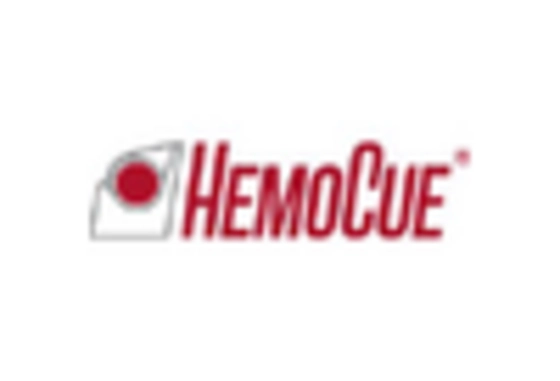Rising Prevalence of Anemia
The increasing incidence of anemia across various demographics is a primary driver for the Hemoglobin Testing Device Market. Anemia affects millions worldwide, with estimates suggesting that approximately 1.62 billion people are anemic. This condition necessitates regular monitoring of hemoglobin levels, thereby propelling demand for testing devices. Healthcare providers are increasingly focusing on early detection and management of anemia, which further emphasizes the need for efficient hemoglobin testing solutions. As awareness about anemia's health implications grows, the market for hemoglobin testing devices is likely to expand, catering to both clinical and home settings. The rising prevalence of chronic diseases, which often correlate with anemia, also contributes to the market's growth, indicating a sustained demand for innovative testing technologies.
Government Initiatives and Funding
Government initiatives aimed at improving healthcare access and quality are significantly influencing the Hemoglobin Testing Device Market. Various health organizations and governments are investing in programs to combat anemia and related disorders, which often include funding for diagnostic tools. For instance, initiatives to provide free or subsidized hemoglobin testing in low-income regions are becoming more prevalent. Such programs not only raise awareness about the importance of hemoglobin monitoring but also stimulate demand for testing devices. Additionally, regulatory support for the development and approval of innovative testing technologies is likely to foster a more competitive market environment. As governments continue to prioritize public health, the market for hemoglobin testing devices is expected to benefit from increased funding and support.
Increased Focus on Preventive Healthcare
The growing emphasis on preventive healthcare is driving the Hemoglobin Testing Device Market. As healthcare systems worldwide shift from reactive to proactive approaches, there is a heightened focus on early detection and management of health conditions, including anemia. Regular hemoglobin testing is becoming an integral part of routine health check-ups, particularly for at-risk populations such as pregnant women and individuals with chronic illnesses. This trend is supported by educational campaigns that promote the importance of monitoring hemoglobin levels for overall health. Consequently, healthcare providers are increasingly incorporating hemoglobin testing into their preventive care protocols, which is likely to boost the demand for testing devices. As awareness of preventive healthcare continues to rise, the market for hemoglobin testing devices is expected to expand.
Growing Demand for Home Healthcare Solutions
The trend towards home healthcare solutions is emerging as a significant driver for the Hemoglobin Testing Device Market. With an increasing number of patients preferring to manage their health conditions at home, the demand for portable and easy-to-use hemoglobin testing devices is on the rise. This shift is particularly evident among elderly populations and individuals with chronic conditions who require regular monitoring of their hemoglobin levels. Home testing devices offer convenience and reduce the need for frequent hospital visits, aligning with the broader trend of personalized healthcare. As manufacturers respond to this demand by developing user-friendly devices, the market is likely to see substantial growth. The home healthcare segment is expected to become a key focus area for companies operating in the hemoglobin testing device sector.
Technological Innovations in Testing Devices
Technological advancements play a crucial role in shaping the Hemoglobin Testing Device Market. Innovations such as point-of-care testing devices and non-invasive hemoglobin measurement technologies are transforming the landscape of hemoglobin testing. These advancements not only enhance the accuracy and speed of results but also improve patient compliance by offering convenient testing options. The market is witnessing a shift towards portable and user-friendly devices, which are particularly appealing in remote and underserved areas. Furthermore, the integration of artificial intelligence and machine learning in testing devices is expected to enhance diagnostic capabilities, thereby driving market growth. As healthcare systems increasingly adopt these technologies, the demand for advanced hemoglobin testing devices is anticipated to rise significantly.

















Leave a Comment